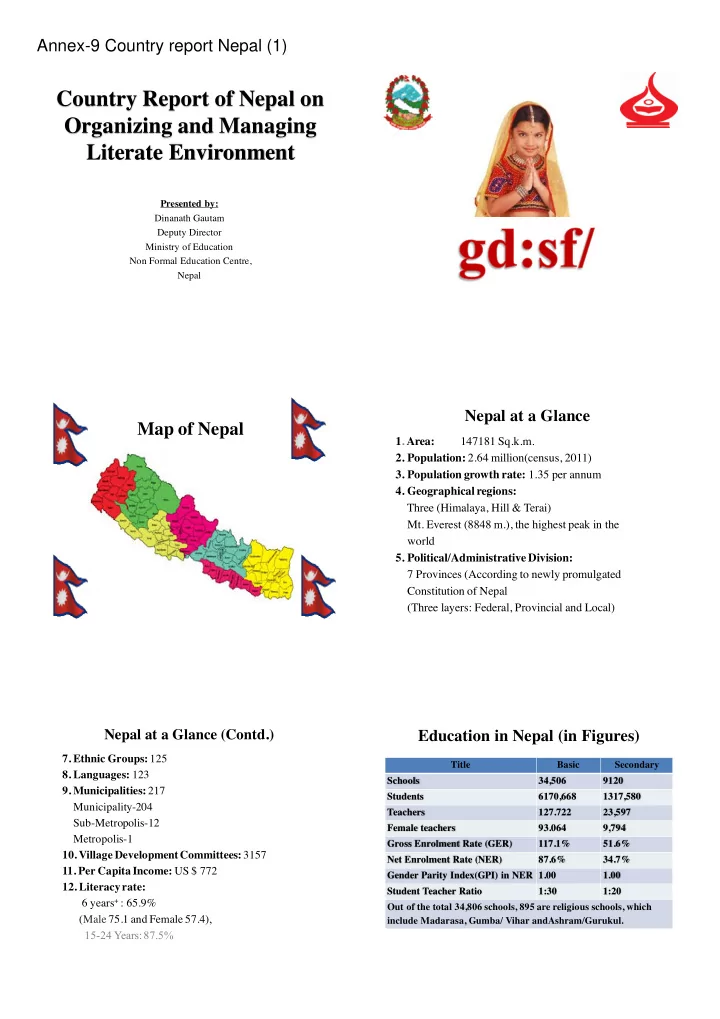

Annex-9 Country report Nepal (1) Country Report of Nepal on Organizing and Managing Literate Environment Presented by: Dinanath Gautam Deputy Director Ministry of Education Non Formal Education Centre, Nepal Nepal at a Glance Map of Nepal 1. Area: 147181 Sq.k.m. 2. Population: 2.64 million(census, 2011) 3. Population growth rate: 1.35 per annum 4. Geographical regions: Three (Himalaya, Hill & Terai) Mt. Everest (8848 m.), the highest peak in the world 5. Political/Administrative Division: 7 Provinces (According to newly promulgated Constitution of Nepal (Three layers: Federal, Provincial and Local) Nepal at a Glance (Contd.) Education in Nepal (in Figures) 7. Ethnic Groups: 125 Title Basic Secondary 8. Languages: 123 Schools 34,506 9120 9. Municipalities: 217 Students 6170,668 1317,580 Municipality-204 Teachers 127.722 23,597 Sub-Metropolis-12 Female teachers 93.064 9,794 Metropolis-1 Gross Enrolment Rate (GER) 117.1% 51.6% 10. Village Development Committees: 3157 Net Enrolment Rate (NER) 87.6% 34.7% 11. Per Capita Income: US $ 772 Gender Parity Index(GPI) in NER 1.00 1.00 12. Literacy rate: Student Teacher Ratio 1:30 1:20 6 years + : 65.9% Out of the total 34,806 schools, 895 are religious schools, which (Male 75.1 and Female 57.4) , include Madarasa, Gumba/ Vihar andAshram/Gurukul. 15-24 Years: 87.5%
Organizational structure of education system Ministry1of1Education TSC HSEB CTEVT UGC Expenses11in1Education1Sector1 Curriculum1 National1 NonFFormal1 Office1of1the1 Development1 Department11of1 Centre1for1 Controller1of1 Education1 17.1 16.6 Educational11 Centre1(CDC) Education1(DOE) Examination1 15.67 Centre1(NFEC) 18 15.65 Development1 (OCE) (NCED) 13.92 16 12.04 14 Regional1 District1NonFFormal1 Educational1 Education1CommitteesF 12 Educational1 75 Directorate1 Training1 10 NFESection1in1District1 (RED)F5 CentresF29 Education1OfficesF75 8 6 Community1 District1Education1 4 Learning1 CommitteesF75 2 Centres District1Education1Offices1 (CLCs)F2151 0 (DEOs)F75 2010/11 2011/12 2012/13 2013/14 2014/15 2015/16 Resource1Centres1(RCs)F10531 including11461Lead1Resource1 Centres1(LRCs) Roles/&/responsibilities/of/the/agencies/under/ School&Structure&of&Education&& MoE in/implementation/of/educational/programs/ Age Grade Types&of&Schooling&System Agencies1 Roles1&1responsibilities1 16 12 15 11 Ministry of Education Policy making Secondary Education 14 10 Department of Education Program design (Grades 9-12) 13 9 Resource allocation Regional Education Directorates Monitoring 12 8 Supervision 11 7 Coordination 10 6 District Education Offices Program Implementation 9 5 Administration of day to day educational activities Basic Education 8 4 (Grades 1-8) Resource Centres Monitoring, supervision & facilitation of school 7 3 activities in school clusters 6 2 5 1 Schools Receiver of the services and resources from district 4 & regional agencies Pre Primary Education Provide educational services to learners /Early Childhood Development 3 Major Policies in Education Major policies in education (Contd.) MoE Nepal has formulated educational policies and Formal education starts from Early Childhood Development (ECD) for 3-4 years’ age group and it is of programs to improve the status of education sector and one year duration. achieve the goal of equitable access to quality education for all. Formal school education consists of basic and secondary education. The government has concentrated its efforts towards Teachers' training and capacity building activities are socially marginalized and deprived communities by carried out by Educational Training Centres (ETC) under working intensively for establishing more inclusive National Centre for Educational Development(NCED) educational environment. and RCs also coordinate and supervise the schools in The guidelines, norms and standards have been set to school clusters. ensure efficient working framework for regional, district Resource Centres (RCs) under District Education and school level. Offices(DEOs).
Objectives of Higher Education Major policies in education (Contd.) Produce high level and internationally competitive skilled workforce capable to contribute to national Curriculum Development Centre (CDC), as the CLA under MoE system, develops school level curricula, prepares and approves economic growth and all round development of the textbooks and other curricular materials to be used in school country; education Produce future leaders for the nation; The children and youths who are dropped out of school education are provided with technical education and vocational training Generate knowledge through research studies and (TEVT) of various levels and trades by the technical and vocational innovative activities; schools under Council for Technical Education Vocational Training Contribute to transferring knowledge and technology; (CTEVT). The Non Formal Education Policy focuses on decentralisation, Preserve historical and cultural heritage of the empowerment and partnerships with the private sector and I/NGO’s country as strategies to achieve goals for adult literacy. Educational planning in Nepal Non1Formal1Education1Programs1in1Nepal Department of Education is the responsible agency for school level Literate/Nepal/Mission/(LINEM)/implemented/for/7/ educational planning. years/with/the/aim/of/eradicating/illiteracy/from/the/ Education plans are designed based on bottom up planning approach. countryI3/months/basic/literacy/package// School Improvement Plan (SIP), Village Education Plan (VEP), District Education Plan (DEP) are prepared with the involvement of concerned Continuous/education/program/Level/1/&/2I 4/months/ stakeholders at the local level. integrated/basic/and/post/literacy/program/ The CLAs under MoE system are responsible for designing and Income/generation/(IG)/activities/and/livelihood/skill/ implementing programmes and monitoring them. development/programs/in/collaboration/with/providers/ Five Regional Education Directorates (REDs) are responsible for monitoring the programmes undertaken by the district level organizations. of/TE,/VT,/livelihood/skills/development/and/other/ Seventy five DEOs and 1053 Resource Centres (RCs) at sub district level development/partners/ are the main implementing agencies of the educational policies, plans and Establishment/and/development/of/CLCs as/the/venue/ programmes at local levels. of/NFE &/Lifelong/learning/in/community/level.//// Partnership1with1Development1 Non1Formal1Education1Programs1in1Nepal1(Contd.) Partners1&1CSOs Alternative/education/program//for/outIofIschool/ children/including/school/dropIoutsI Basket1fund1for1Implementing1Educational1 ! 6/years/condensed/program/for/grade/1I10/ ProgramsFDOE ! Alternative/primary/education/of/3/years/equivalent/ Established1NFE Network1for1Partnership1&1 to/grade/1I5/of/formal/education// CollaborationFNFEC ! Open/schooling/program/of/2/years/equivalent/to/ grade/6I8/and/1/year/for/grade/9I10 Responsibility1of1Local1Government1Agencies1 ! School/Outreach/Program/(SOP)/for/school/going/age/ in1Implementing1Formal1and1Non1Formal1 childrenIproviding/1I3/grade/formal/education/in/ Education11 NFE modeIGovernment/program/phased/out/but/ Mobilization1of11local1NGOs1&1CBOs for1 CBOs working/in/child/right,/child/education/etc./ Literate1Nepal1Mission1(LINEM)1 carry/out/SOP///
Partnership with UNESCO Support for enhancing the effectiveness of the system for implementing literacy and other NFE programs. Support for Literate Nepal Mission (LINEM) Support to integrate life and livelihood skills in NFE, develop alternative and open education system equivalent to formal education. Support for development of NFE-MIS. Capacity development for implementing Education for All (EFA) program activities.
Recommend
More recommend